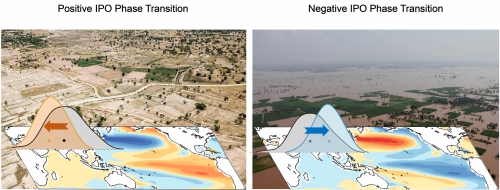
The South Asian summer monsoon (SASM) provides principal water supply for over a billion people. In good monsoon years, farmers reap a rich harvest, while in bad monsoon years, severe droughts wipe out crops. And heavy rains during monsoon season cause floods and hit economy.
Policy-makers and stakeholders urgently need projection of SASM for the coming 15-30 years - usually termed as "near future" in climate research community. Unfortunately, there are large uncertainties in the current projection due to climate internal variability.
"Internal variability refers to variations in the mean state due to natural internal processes within the climate system. It is usually regarded as 'noise' in climate projection." Said HUANG Xin, the lead author of a new study published in Science Advances on March 13. HUANG is a doctoral student with the Institute of Atmospheric Physics (IAP) of the Chinese Academy of Sciences, and the University of Chinese Academy of Sciences.
HUANG, along with her mentor Prof. ZHOU Tianjun from IAP and collaborators from USA and Germany, identify the Interdecadal Pacific Oscillation (IPO) - a large-scale long period oscillation influencing climate variability over the Pacific Basin - as one of the key internal variability modes that reduce the uncertainties and improve projections.
The team used a 100-member ensemble of simulations by the Max Planck Institute Earth System Model (MPI-ESM) and a 50-member ensemble of simulations by the Canadian Earth System Model (CanESM2) to quantify the uncertainty caused by internal variability in the near-future projection of SASM rainfall.
"We found that internal variability can eclipse the externally forced SASM rainfall change, leading to very different rainfall trends for next 15-30 years," said HUANG. "So we wanted to further identify the key internal mode responsible for the spread in the projected SASM rainfall."
After analyzing the similarities and differences among the 150-member model projections, the team found a linkage between different realizations of the IPO phase and the spread in the SASM rainfall projection. Different IPO phase transitions can modulate the magnitude or even reverse the sign of the SASM rainfall trends. Thus, the IPO is identified as one of the leading internal modes influencing the near-term projection of SASM rainfall.
"Historical data have already shown the signal of IPO in SASM change, but the climate projection community usually regarded the signal as noise in the projection. We show evidences that accounting for future IPO phase evolution helps effectively reduce the projection uncertainty of near-term SASM rainfall; in particular, it improves the projection of an extreme wetting or drying trend for the next 15-30 years," said HUANG.

A positive IPO phase transition indicates more chance of an extreme drying trend, while the flood occurs at a negative IPO phase transition. (Image by HUANG Xin)
The findings highlight the urgent need to predict IPO evolution for the next few decades.
"A large part of climate change adaptation and mitigation activities is based on prognoses delivered by climate models, so a highly robust and reliable climate prediction is the base of policy decision making. This research provides a practical way of more reliably projecting near-term South Asian summer monsoon changes," said Prof. ZHOU Tianjun, corresponding author of the study.
According to ZHOU, the study is part of GMMIP efforts devoting to improving the predictive skill for monsoons for the upcoming decades, which in turn will help policy-makers and stakeholders develop better climate strategies.

86-10-68597521 (day)
86-10-68597289 (night)

52 Sanlihe Rd., Xicheng District,
Beijing, China (100864)

